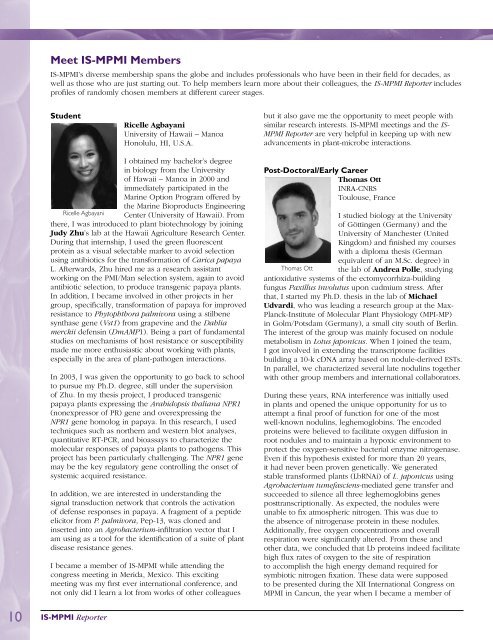IS-MPMI Reporter - International Society for Molecular Plant-Microbe ...
IS-MPMI Reporter - International Society for Molecular Plant-Microbe ...
IS-MPMI Reporter - International Society for Molecular Plant-Microbe ...
Create successful ePaper yourself
Turn your PDF publications into a flip-book with our unique Google optimized e-Paper software.
Meet <strong>IS</strong>-<strong>MPMI</strong> Members<br />
<strong>IS</strong>-<strong>MPMI</strong>’s diverse membership spans the globe and includes professionals who have been in their field <strong>for</strong> decades, as<br />
well as those who are just starting out. To help members learn more about their colleagues, the <strong>IS</strong>-<strong>MPMI</strong> <strong>Reporter</strong> includes<br />
profiles of randomly chosen members at different career stages.<br />
Student<br />
10 <strong>IS</strong>-<strong>MPMI</strong> <strong>Reporter</strong><br />
Ricelle Agbayani<br />
University of Hawaii – Manoa<br />
Honolulu, HI, U.S.A.<br />
I obtained my bachelor’s degree<br />
in biology from the University<br />
of Hawaii – Manoa in 2000 and<br />
immediately participated in the<br />
Marine Option Program offered by<br />
the Marine Bioproducts Engineering<br />
Ricelle Agbayani Center (University of Hawaii). From<br />
there, I was introduced to plant biotechnology by joining<br />
Judy Zhu’s lab at the Hawaii Agriculture Research Center.<br />
During that internship, I used the green fluorescent<br />
protein as a visual selectable marker to avoid selection<br />
using antibiotics <strong>for</strong> the trans<strong>for</strong>mation of Carica papaya<br />
L. Afterwards, Zhu hired me as a research assistant<br />
working on the PMI/Man selection system, again to avoid<br />
antibiotic selection, to produce transgenic papaya plants.<br />
In addition, I became involved in other projects in her<br />
group, specifically, trans<strong>for</strong>mation of papaya <strong>for</strong> improved<br />
resistance to Phytophthora palmivora using a stilbene<br />
synthase gene (Vst1) from grapevine and the Dahlia<br />
merckii defensin (DmAMP1). Being a part of fundamental<br />
studies on mechanisms of host resistance or susceptibility<br />
made me more enthusiastic about working with plants,<br />
especially in the area of plant-pathogen interactions.<br />
In 2003, I was given the opportunity to go back to school<br />
to pursue my Ph.D. degree, still under the supervision<br />
of Zhu. In my thesis project, I produced transgenic<br />
papaya plants expressing the Arabidopsis thaliana NPR1<br />
(nonexpressor of PR) gene and overexpressing the<br />
NPR1 gene homolog in papaya. In this research, I used<br />
techniques such as northern and western blot analyses,<br />
quantitative RT-PCR, and bioassays to characterize the<br />
molecular responses of papaya plants to pathogens. This<br />
project has been particularly challenging. The NPR1 gene<br />
may be the key regulatory gene controlling the onset of<br />
systemic acquired resistance.<br />
In addition, we are interested in understanding the<br />
signal transduction network that controls the activation<br />
of defense responses in papaya. A fragment of a peptide<br />
elicitor from P. palmivora, Pep-13, was cloned and<br />
inserted into an Agrobacterium-infiltration vector that I<br />
am using as a tool <strong>for</strong> the identification of a suite of plant<br />
disease resistance genes.<br />
I became a member of <strong>IS</strong>-<strong>MPMI</strong> while attending the<br />
congress meeting in Merida, Mexico. This exciting<br />
meeting was my first ever international conference, and<br />
not only did I learn a lot from works of other colleagues<br />
but it also gave me the opportunity to meet people with<br />
similar research interests. <strong>IS</strong>-<strong>MPMI</strong> meetings and the <strong>IS</strong>-<br />
<strong>MPMI</strong> <strong>Reporter</strong> are very helpful in keeping up with new<br />
advancements in plant-microbe interactions.<br />
Post-Doctoral/Early Career<br />
Thomas Ott<br />
INRA-CNRS<br />
Toulouse, France<br />
I studied biology at the University<br />
of Göttingen (Germany) and the<br />
University of Manchester (United<br />
Kingdom) and finished my courses<br />
with a diploma thesis (German<br />
equivalent of an M.Sc. degree) in<br />
Thomas Ott<br />
the lab of Andrea Polle, studying<br />
antioxidative systems of the ectomycorrhiza-building<br />
fungus Paxillus involutus upon cadmium stress. After<br />
that, I started my Ph.D. thesis in the lab of Michael<br />
Udvardi, who was leading a research group at the Max-<br />
Planck-Institute of <strong>Molecular</strong> <strong>Plant</strong> Physiology (MPI-MP)<br />
in Golm/Potsdam (Germany), a small city south of Berlin.<br />
The interest of the group was mainly focused on nodule<br />
metabolism in Lotus japonicus. When I joined the team,<br />
I got involved in extending the transcriptome facilities<br />
building a 10-k cDNA array based on nodule-derived ESTs.<br />
In parallel, we characterized several late nodulins together<br />
with other group members and international collaborators.<br />
During these years, RNA interference was initially used<br />
in plants and opened the unique opportunity <strong>for</strong> us to<br />
attempt a final proof of function <strong>for</strong> one of the most<br />
well-known nodulins, leghemoglobins. The encoded<br />
proteins were believed to facilitate oxygen diffusion in<br />
root nodules and to maintain a hypoxic environment to<br />
protect the oxygen-sensitive bacterial enzyme nitrogenase.<br />
Even if this hypothesis existed <strong>for</strong> more than 20 years,<br />
it had never been proven genetically. We generated<br />
stable trans<strong>for</strong>med plants (LbRNAi) of L. japonicus using<br />
Agrobacterium tumefasciens-mediated gene transfer and<br />
succeeded to silence all three leghemoglobins genes<br />
posttranscriptionally. As expected, the nodules were<br />
unable to fix atmospheric nitrogen. This was due to<br />
the absence of nitrogenase protein in these nodules.<br />
Additionally, free oxygen concentrations and overall<br />
respiration were significantly altered. From these and<br />
other data, we concluded that Lb proteins indeed facilitate<br />
high flux rates of oxygen to the site of respiration<br />
to accomplish the high energy demand required <strong>for</strong><br />
symbiotic nitrogen fixation. These data were supposed<br />
to be presented during the XII <strong>International</strong> Congress on<br />
<strong>MPMI</strong> in Cancun, the year when I became a member of


